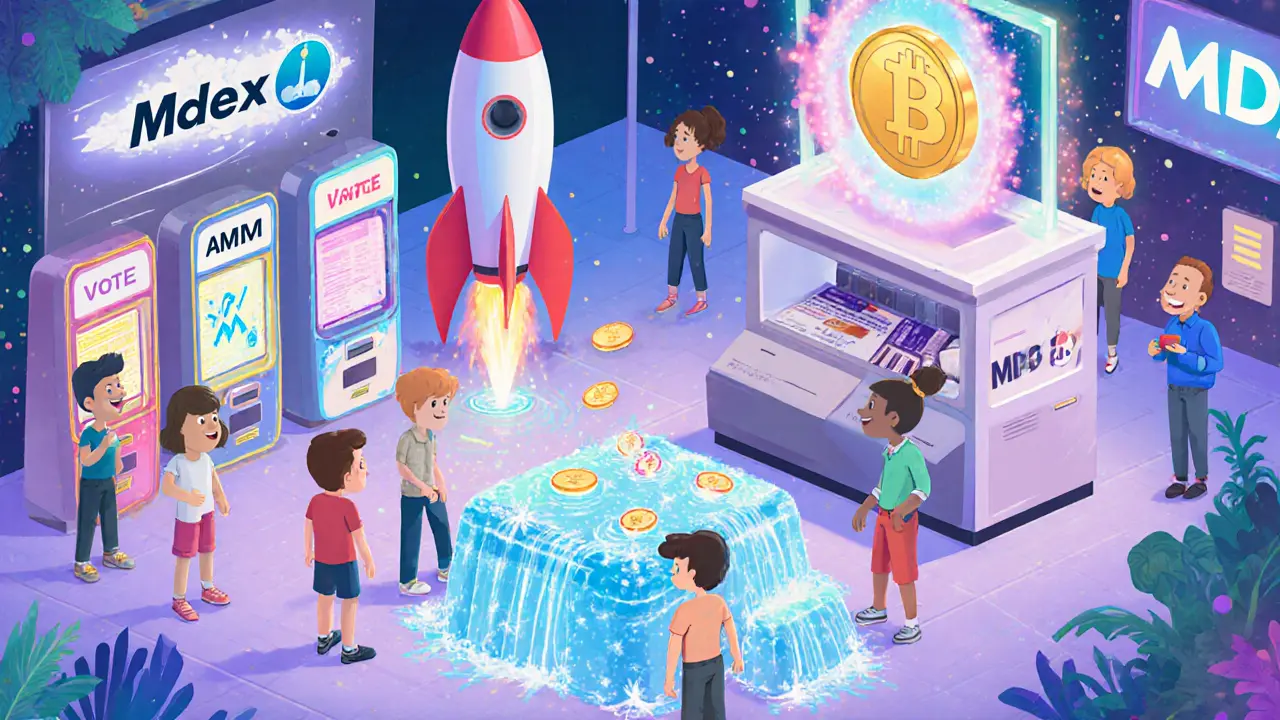
- 10 Sep 2025
- Elara Crowthorne
- 18
Mdex (MDX) Token Calculator
Current MDX Supply
Total supply cap
Token Distribution
Liquidity Mining Calculator
Potential MDX Rewards
MDX vs. Other DEX Tokens Comparison
| Metric | MDX | UNI | SUSHI |
|---|---|---|---|
| Primary Chain | Ethereum & HECO | Ethereum | Ethereum |
| Avg. Transaction Fee | ~$0.01 (HECO) | ~$2-$5 (Ethereum) | ~$2-$5 (Ethereum) |
| Block Time | 3 seconds (HECO) | ≈13 seconds (Ethereum) | ≈13 seconds (Ethereum) |
| Governance Model | DAO with MDX voting | UNI-based DAO | SUSHI DAO |
| Liquidity Mining Focus | 80% of supply dedicated | ~20% of supply | ~30% of supply |
Quick Takeaways
- Mdex (MDX) is the native governance and utility token of the Mdex DeFi platform.
- It runs on a dual‑chain model: Ethereum for liquidity and HECO for fast, cheap transactions.
- 80% of the 1billion token supply fuels liquidity‑mining and transaction‑mining rewards.
- Beyond swapping, Mdex offers a launchpad (IMO), DAO voting, fiat gateways, and margin trading.
- MDX crypto coin can be earned by providing liquidity, bought on several exchanges, and stored in any ERC‑20 compatible wallet.
What is Mdex (MDX)?
Mdex is a decentralized exchange (DEX) protocol that combines automated market making (AMM) with cross‑chain capabilities. It launched in January2022 and has operated without any reported security breaches. The platform’s native token, MDX, serves both as a governance token and a utility token, giving holders voting rights and access to fee discounts, liquidity‑mining rewards, and other incentives.
Technical Architecture: Dual‑Chain Model
Mdex’s backbone consists of two blockchains:
- Ethereum - provides access to the broader DeFi ecosystem and deep liquidity pools.
- Huobi Eco Chain (HECO) - offers 3‑second block times and dramatically lower transaction fees.
By bridging assets between Ethereum and HECO, Mdex lets users enjoy Ethereum’s market depth while avoiding its high gas costs during congestion. Each HECO block mints 80 MDX tokens, and a halving mechanism cuts rewards by 50% every six months, similar to Bitcoin but on a compressed schedule.

Tokenomics: How the 1Billion MDX Tokens Are Distributed
The total supply is capped at 1billion MDX. Here’s the breakdown:
| Allocation | Percentage | Purpose |
|---|---|---|
| Liquidity & Transaction Mining | 80% | Rewards for users who provide liquidity and trade on HECO |
| Team & Development | 10% | Ongoing development, operations, and future incentives |
| Early Investors | 7% | Seed funding and strategic partnerships |
| Marketing & Brand Building | 3% | Community growth, promotions, and ecosystem outreach |
As of the latest snapshot, roughly 278million MDX tokens are circulating, trading around $0.0166 each. Prices fluctuate quickly, so always check a reliable market feed before buying.
Platform Features Beyond Simple Swaps
Mdex positions itself as a full‑stack DeFi environment. Key modules include:
- Automated Market Maker (AMM) - instant token swaps without order books.
- Initial Mdex Offering (IMO) - a launchpad where new projects can raise funds directly on the platform. IMO offers token sales, community vetting, and early‑access incentives.
- DAO Governance - MDX holders vote on protocol upgrades, fee structures, and strategic decisions. DAO ensures that the community steers the roadmap.
- Liquidity Mining - providers earn MDX for supplying assets to pools, creating a passive income stream.
- Fiat Gateway & Credit Card Purchases - users can convert fiat directly into MDX via integrated partners.
- Margin & Leverage Trading - advanced traders can amplify positions using borrowed capital.
- OTC Desk - large‑volume trades executed off‑chain to avoid slippage.
How to Acquire and Use MDX
There are three main pathways:
- Buy on Centralized Exchanges - platforms like Binance, KuCoin, and Gate.io list MDX against USDT, BTC, and other pairs.
- Swap on Mdex DEX - connect an ERC‑20 compatible wallet (MetaMask, Trust Wallet) and trade directly for MDX on the HECO side.
- Earn via Liquidity Mining - deposit supported token pairs into Mdex pools and receive MDX rewards automatically.
Once you have MDX, you can stake it for fee discounts, vote in the DAO, or hold it for potential price appreciation.
Mdex vs. Other Popular DEX Tokens
Below is a quick side‑by‑side look at how MDX stacks up against Uniswap’s UNI and SushiSwap’s SUSHI.
| Metric | MDX | UNI | SUSHI |
|---|---|---|---|
| Primary Chain | Ethereum & HECO | Ethereum | Ethereum |
| Avg. Transaction Fee | ~$0.01 (HECO) | ~$2‑$5 (Ethereum) | ~$2‑$5 (Ethereum) |
| Block Time | 3seconds (HECO) | ≈13seconds (Ethereum) | ≈13seconds (Ethereum) |
| Governance Model | DAO with MDX voting | UNI‑based DAO | SUSHI DAO |
| Liquidity Mining Focus | 80% of supply dedicated | ~20% of supply | ~30% of supply |
MDX’s dual‑chain design gives it a clear cost advantage for small‑ticket traders, while its tokenomics heavily reward liquidity providers.
Risks and Considerations
Even with a clean security record, any DeFi protocol carries inherent risks:
- Smart‑contract bugs - code flaws could lead to fund loss.
- Cross‑chain bridges - bridging assets between Ethereum and HECO adds an extra attack surface.
- Regulatory uncertainty - many jurisdictions are still defining rules for DEXs and token sales.
- Market volatility - MDX’s price can swing dramatically, especially after halving events.
Do your own research, diversify holdings, and consider using hardware wallets for large amounts.
Future Outlook
Mdex’s roadmap emphasizes tighter cross‑chain integration, new launchpad features, and broader fiat on‑ramps. If DeFi continues moving toward multi‑chain interoperability, MDX could benefit from growing demand for low‑fee, fast trading experiences.
Frequently Asked Questions
What does MDX stand for?
MDX is simply the ticker symbol for the native token of the Mdex platform. It does not represent an acronym; it’s used for trading and identification across exchanges.
Is MDX an ERC‑20 token?
Yes. On Ethereum, MDX follows the ERC‑20 standard, allowing it to be stored in any compatible wallet. On HECO, it exists as an equivalent BEP‑20 style token.
How can I earn MDX without buying it?
Provide liquidity to Mdex pools or participate in transaction mining programs. The platform automatically distributes MDX rewards based on your share of the pool.
What is the role of the DAO in Mdex?
MDX holders vote on proposals that affect fee structures, new feature rollouts, and protocol upgrades. Decisions are executed on‑chain, ensuring transparency.
Can I use MDX on other DeFi platforms?
Because MDX is an ERC‑20 token, it can be integrated into any Ethereum‑compatible DeFi app that supports custom tokens, though liquidity may be limited outside the Mdex ecosystem.
Understanding the MDX crypto coin fundamentals, tokenomics, and ecosystem tools can help you decide whether it fits your trading strategy or long‑term investment plan.

18 Comments
Hey folks, MDX is an interesting token that aims to boost liquidity on both Ethereum and HECO.
Its 80% allocation to liquidity mining makes it stand out from other DEX tokens.
Just keep an eye on the DAO governance to see how the community shapes its future.
Liquidity incentives are a double‑edged sword; they can attract capital but also create volatility.
Understanding the tokenomics helps you navigate that balance.
MDX is a game‑changer!!! The near‑zero fees on HECO make trading cheap and fast!!! With 80% of supply dedicated to mining, we’re looking at massive yield potential!!! Don’t miss the DAO votes – your voice matters!!!
Yo, i think MDX could be the next big thang in dexs!! The low gas fee on HECO is like music to my ears!! Just watch the team’s moves, they’re kinda slick.
Think of MDX as a tool that can help you diversify your DeFi portfolio.
Its focus on liquidity mining gives you a steady stream of rewards if you stay patient.
Just remember to manage risk like any other investment.
When you add MDX to a liquidity pool, you’re essentially earning a share of the transaction fees plus mining incentives.
It’s a win‑win if the pool stays healthy.
Check the calculator regularly to see how your rewards evolve.
There’s a hidden narrative behind MDX that most casual investors ignore, and it starts with the concentration of token supply.
When 80% of the total is earmarked for liquidity mining, a small group of early participants can exert outsized influence over price stability.
This concentration creates a feedback loop where scarcity appears engineered, yet the markets remain susceptible to pump‑and‑dump schemes.
Moreover, the DAO’s voting power is weighted by MDX holdings, meaning that governance can become a veneer for a plutocratic system.
Such a structure invites regulatory scrutiny, especially as authorities worldwide tighten standards on DeFi projects that resemble securities.
Adding to the intrigue, the cross‑chain deployment on HECO introduces additional opacity, since transaction data on that chain is less scrutinized than Ethereum.
Critics argue that the low transaction fee is a smokescreen, masking potential centralization of mining rewards.
Furthermore, the token’s early investors, holding 7%, often have venture‑backed connections that can sway development roadmaps.
One cannot overlook the marketing allocation; a modest 3% may seem trivial, but strategic partnerships can amplify brand perception far beyond the numbers.
In practice, the token’s price has shown periods of hyper‑inflation followed by sharp corrections, a pattern that aligns with the “whale‑driven” theory.
From a macro perspective, the Ethereum congestion that drives users to HECO also fuels speculative swaps into MDX, inflating demand artificially.
Some community members, driven by optimism, overlook these systemic risks, leading to echo chambers that reinforce bullish sentiment.
Nevertheless, the token’s technical merits-fast block times and low fees-do provide genuine utility for traders seeking efficiency.
In the end, investors must weigh the alluring rewards against the structural vulnerabilities embedded within MDX’s design.
MDX looks promising, especially with those cheap fees on HECO! 🌟 It’s great for quick swaps and the DAO gives us a voice. 👍 Keep an eye on the token distribution, though.
Whilst the prospect of diminished transaction costs is undeniably appealing, one must also consider the inherent risks associated with a token whose majority allocation is directed toward liquidity mining; such a distribution may precipitate market manipulation, thereby undermining the purported decentralisation; consequently, a prudent investor should conduct exhaustive due‑diligence before allocating capital.
MDX’s cross‑chain architecture offers flexibility, but remember that cross‑chain bridges can be vulnerable.
Hey there! I’ve been tracking MDX for a while, and the low fees really help me trade more often.
Just don’t forget to watch the DAO proposals – they can change the game quickly.
The design of MDX appears to be thoughtfully calibrated for both liquidity provision and community governance.
By allocating a substantial portion of the supply to mining rewards, the token incentivizes participation from a broad user base.
This, in turn, can enhance market depth and reduce slippage for traders.
Simultaneously, the DAO framework empowers holders to shape protocol upgrades, fostering a sense of ownership.
Such a dual‑focus strategy could position MDX favorably within the competitive DEX landscape.
Nevertheless, sustained success will depend on transparent communication from the development team.
Regular updates and clear roadmaps are essential to maintain investor confidence.
Overall, MDX offers a compelling blend of utility and participatory governance.
i think MDX is pretty cool but dont forget to check the fees on your own.
its always good to do a quick math before you jump in.
Yo, MDX is blowing up like a firecracker! Everyone’s talking about the cheap swaps, but the hype can get outta hand.
Watch out for those whales, they can crash the price in seconds.
The tokenomics are clear; 80% for mining, 10% for devs-makes sense, right?;
Just keep an eye on the DAO votes; they can shift the direction fast.
Understanding MDX’s architecture can be overwhelming, so take it step by step and focus on the aspects that align with your risk tolerance.
It is irresponsible to promote MDX without highlighting the potential for centralisation of power.
Investors deserve full disclosure about how voting weight is distributed.
Keep it simple, folks.